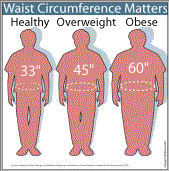
BODY COMPOSITION
By Danielle Stull, RN
October 23, 2007
Medical professionals commonly use body composition to assess health and risk of disease. The definition of body composition
is the difference between the fat component of your body and the fat free component. The fat free component contains your
muscle and bone. The ratio of body fat to other components is calculated to determine your percentage of body fat. Excessive
body fat is associated with a number of disease conditions such as type 2 diabetes, high blood pressure, heart disease,
and hypercholesteremia. The current American College of Sports Medicine recommendation for adult men is 10 to 22 percent
body fat, while women should have between 20 and 32 percent.
The most accurate method of body composition measurement is hydrostatic (underwater) weighing. All other assessment methods
provide only an estimate of body composition. Deciding on which method to use depends on the purpose of the test and the
availability of equipment. The most common methods are body mass index (BMI), circumference measurements, skinfold measurements,
and bioelectrical impedance analysis.
The gold standard in determining body composition is hydrostatic weighing; a procedure requiring specialized equipment and
training. Underwater weighing involves submerging an individual in a pool or a large tank and measuring their weight while
submerged (this is not usually seen in a health club setting). Most proathletic or college teams will have a facility where
this type of testing is done.

BMI is calculated from body weight and height. Although easy to determine, this method does not take into account the difference
between muscle weight and fat weight. Because muscle weighs more, a physically fit person could have a BMI factor usually
associated with those overweight. Other BMI influences are age, gender, and race.
Measuring the circumference of the body at different locations can provide information about body fat distribution. For
example, a waist circumference greater than 40 inches for men and 35 inches for women indicates a greater risk for heart
disease.
Skinfold measurements can also provide a reasonably accurate measurement of body fat. Taken using a caliper at different
anatomical sites, skinfold measurements are based on the assumption that 1/3 of the body's total fat is located beneath
the skin; however, the amount varies with age, gender, and race. Because of this variation, different equations are used
to predict one's percentage of body fat. An experienced technician using properly calibrated calipers and good technique
should conduct the procedure.

Bioelectrical impedance analysis involves passing an undetectable electrical current through the body and measuring its
resistance to the current. Because fat is a poor conductor of electricity, the more fat you have, the longer it takes for
the current to go from head to toe. Plus, there are a few factors that can affect the results of the test including proper
hydration and a woman's menstrual cycle.
It is important to maintain an appropriate percentage of body fat to help reduce your risks for many chronic diseases such
as diabetes, heart disease, and certain cancers. For the general population, simple body composition assessment methods
like BMI, circumference measurements, and skinfold measurements provide a sufficient estimate of body composition. Using
these measurements can help you set up realistic goals in your quest to be healthier.